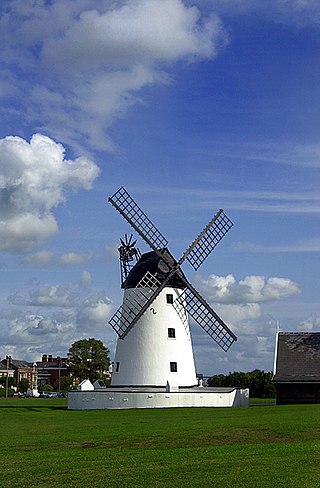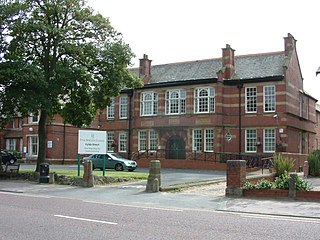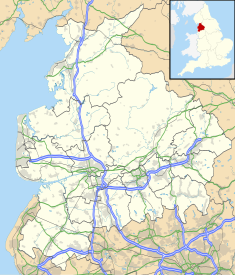
Lytham St Annes is a seaside town in the Borough of Fylde in Lancashire, England. It is on the Fylde coast, directly south of Blackpool on the Ribble Estuary. The population of the built-up area at the 2021 census was 42,695. The town is made up of the four areas of Lytham, Ansdell, Fairhaven and St Annes-on-the-Sea.

The Borough of Fylde is a local government district with borough status in Lancashire, England. It covers part of the Fylde plain, after which it is named. The council's headquarters are in St Annes. The borough also contains the towns of Kirkham, Lytham and Wesham and surrounding villages and rural areas.

Ansdell and Fairhaven railway station is on the Blackpool South to Preston railway line in Lancashire, England. In the past, it has also been known as Ansdell Station, Ansdell's Gate station and Ansdell's Halt.

Richard Ansdell was a British painter of animals and genre scenes.

Fylde Borough Council elections are held every four years to elect councillors to Fylde Borough Council in Lancashire, England. Since the last boundary changes in 2023 the council has comprised 37 councillors, representing 17 wards, with each ward electing one, two or three councillors.

Bryning-with-Warton is a civil parish in the Borough of Fylde in Lancashire, England.
The Fylde is a coastal plain in western Lancashire, England. It is roughly a 13-mile-long (21-kilometre) square-shaped peninsula, bounded by Morecambe Bay to the north, the Ribble estuary to the south, the Irish Sea to the west, and the foot of the Bowland hills to the east which approximates to a section of the M6 motorway and West Coast Main Line.

Westby-with-Plumptons is a civil parish in Lancashire, England. The parish is in Fylde district and contains the hamlets of Great Plumpton, Little Plumpton, Lower Ballam, Higher Ballam, Moss Side, Peel, and Westby. At the 2011 census, the parish had a population of 1,205. Westby and Plumpton are mentioned in the Domesday Book, as "Westbi" and "Pluntun".

The Carnegie Library is in Lytham St Annes, Lancashire, England. The foundation stone of St. Anne's Library was laid in August 1904 and the building was officially opened on 10 January 1906. The land was given by the St. Anne's on the Sea Land and Building Company, and Andrew Carnegie paid for the building itself. This was the first library in the town. There is also a library at Lytham.

St Annes Pier is a Victorian era pleasure pier in the English seaside resort of St Annes-on-the-Sea, Lancashire. It lies on the estuary of the River Ribble. The pier, designed by Alfred Dowson, was completed in 1885 and was one of the earliest public buildings in St Annes, a 19th-century planned town. The pier was originally intended to be a sedate promenading venue for the resort's visitors, but attractions were later added. Changes made to the estuary channels to improve access to Preston Dock left the pier on dry land and ended its steamer services to Blackpool and Liverpool.

St Thomas' Church is an Anglican church in St Anne's-on-the-Sea, a town on the Fylde coastal plain in Lancashire, England. It is an active parish church in the Diocese of Blackburn and the archdeaconry of Lancaster. Designed by Austin and Paley, it is recorded in the National Heritage List for England as a designated Grade II listed building.
St. Anne's on the Sea Land and Building Company was formed in 1874 and played an integral part in the development of the new town of St.Anne's on the Sea from 1875. The company had its roots in the Rossendale area and the most significant investor was William John Porritt, a woollen manufacturer from Helmshore. His money contributed to the building of St Anne's and restored confidence in the project after some early problems.

Lytham Windmill is situated on Lytham Green in the coastal town of Lytham St Annes, Lancashire, England. It is of the type known as a tower mill and was designed for grinding wheat and oats to make flour or bran. Since commercial milling on the site ceased in 1921 the mill has belonged to the town and is operated by Fylde Borough Council, who open it to the public during the summer. The mill also contains a museum run by the Lytham Heritage Trust which explains the history and practice of flour milling.

The Lytham St Annes Art Collection is a public art collection of over 240 artworks in Lytham St Annes, Lancashire. Fylde Borough Council are the custodians of the paintings, sculptures, prints and artefacts that are mostly held within the Lytham St Annes Town Hall. The collection was started in 1925 by the donation of Herd Lassie, painted by Richard Ansdell, to the townspeople of Lytham St Annes, Lancashire. It was donated by John Booth (1857–1941), son of the founder of the grocery store chain Booths. The collection of 25 works is now one of the largest public collections of Ansdell's paintings.

Lytham library was built originally as a Mechanics Institute. It included a small library of books and a reading room and opened on 30 August 1878. The building was extended in 1898 to celebrate Queen Victoria's Diamond Jubilee, including a new reading room, gymnasium and classrooms. The extension was opened by the Duke of Norfolk. In 1922 the library became part of the Municipal Borough of Lytham St Annes with the amalgamation of St Anne's on the Sea and Lytham Urban District Councils. In 1974 the administration of the library was taken over by Lancashire County Council. In Buildings of England Hartwell and Pevsner describe its 'Dark red and yellow and black brick dressings, including dentil sill bands and 'quoins'. Steep coped gables with jaunty finials, and lancets. Bay windows of yellow brick'.

Lytham Pier, a pleasure and working pier, was opened in the seaside town of Lytham, Lancashire, England in 1865, in the face of reservations from local residents. The pier underwent several renovations during the 1890s and early 1900s before being badly damaged by a storm in 1903, during which two barges collided with the structure and split it in two. A fire in 1928 resulted in extensive damage to the pavilion, which was not rebuilt, although the pier itself was reopened several months later. Following a period of decline it was closed to the public shortly before the outbreak of the Second World War. The pier was demolished in 1960 despite the protests of thousands of local residents.

St Annes's Public Offices is a municipal building in Clifton Drive, St Anne's-on-the-Sea, Lancashire, England. The building, which was the headquarters of St Anne's-on-the-Sea Urban District Council, is Grade II listed.

The Old Town Hall is a building on Church Street in the market town of Poulton-le-Fylde in Lancashire, England. Located to the north of Market Place, the building was originally a public house before becoming a municipal building and then reverting to use as a public house.
The Fylde Tournament also known as the Fylde Tennis Tournament was a grass court tennis tournament founded in 1885 by the Fylde Lawn Tennis Club and first played at the Lytham Cricket Club Ground, Lytham St Annes, Lancashire, England. The tournament was played at until 1914.
Public transport in the Fylde is available for three modes of transport—bus, rail and tram—assisting residents of and visitors to the Fylde, a coastal plain in western Lancashire, England, to travel around much of the area's 64 square miles (170 km2).



















